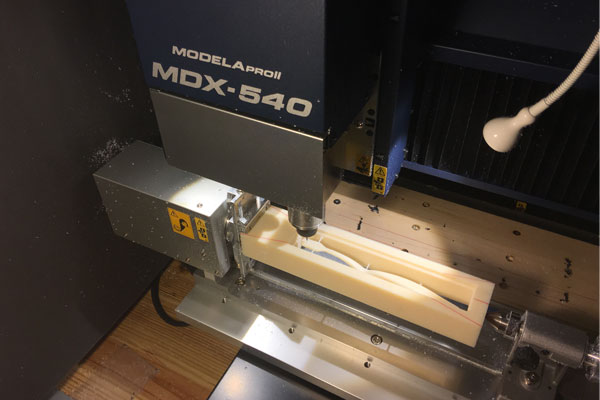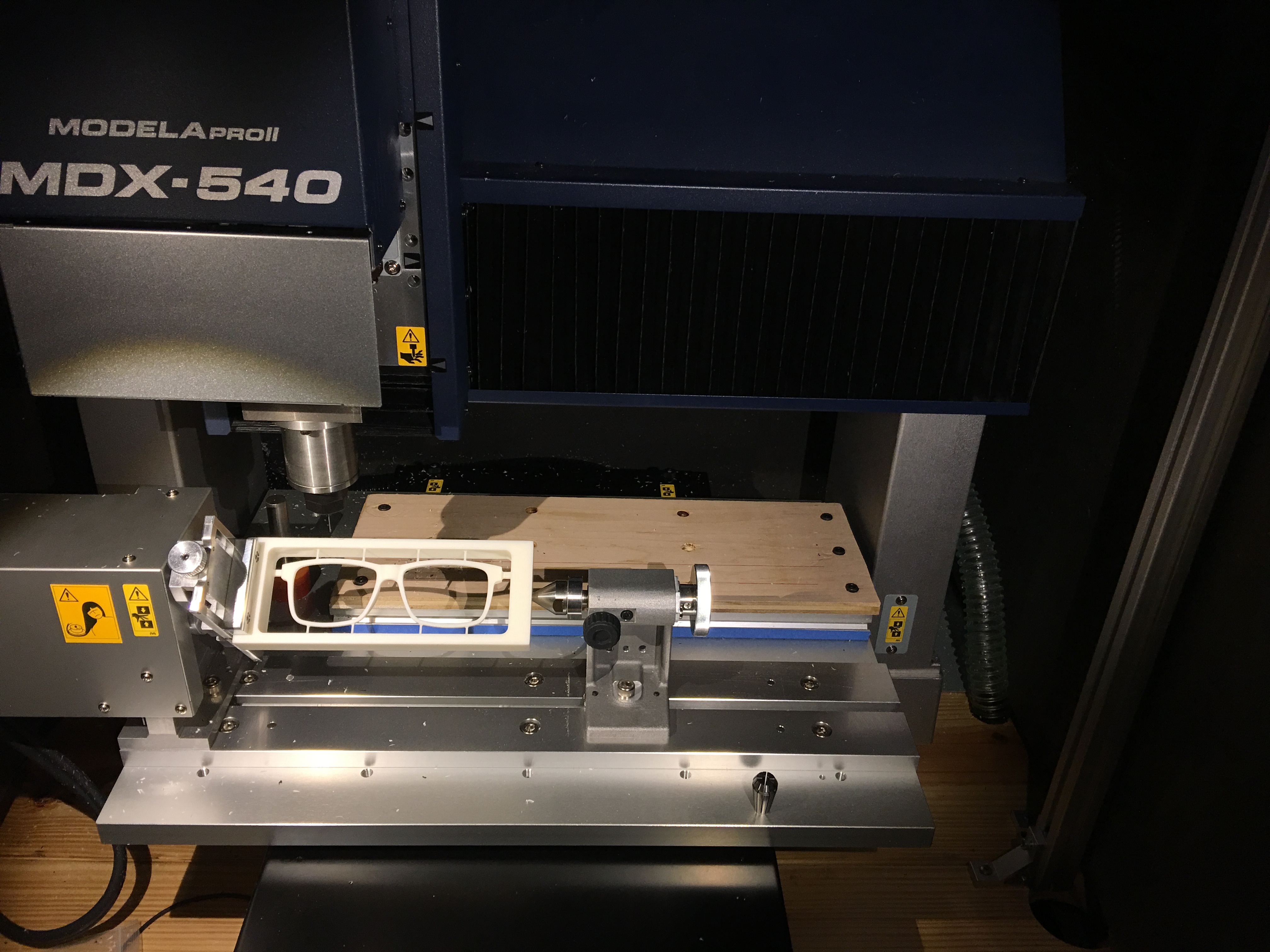Envisioning New Markets with Roland MDX Technology
Tayyebi got the idea of creating his own line of premium eyeglass frames several years ago.

Tayyebi purchased a Roland MODELA MDX-540 benchtop milling machine along with the optional rotary axis. His first experience with Roland’s MDX mills dates to more than a decade ago. Image courtesy of Amir Tayyebi/Roland Public Relations.
October 22, 2018
Amir Tayyebi of Atlanta, GA, really enjoys designing intricate products. “I try not to call myself a workaholic, but most of my free time is dedicated to design and fabrication,” says Tayyebi.
He earned two master’s degrees in product design and manufacturing and has been working in R&D for a decade. Currently, a senior product designer for SoftWear Automation, an automation and robotics company, Tayyebi fills his evening and weekend hours with work on his own designs, including a line of high-end eyeglass frames made from buffalo horn and other premium substrates.
 Currently, a senior product designer for SoftWear Automation, an automation and robotics company, Tayyebi fills his evening and weekend hours with work on his own designs, including a line of high-end eyeglass frames made from buffalo horn and other premium substrates. Image courtesy of Amir Tayyebi/Roland Public Relations.
Currently, a senior product designer for SoftWear Automation, an automation and robotics company, Tayyebi fills his evening and weekend hours with work on his own designs, including a line of high-end eyeglass frames made from buffalo horn and other premium substrates. Image courtesy of Amir Tayyebi/Roland Public Relations.To accomplish his off-hours production, Tayyebi purchased a Roland MODELA MDX-540 benchtop milling machine along with the optional rotary axis. His first experience with Roland's MDX mills was as a student more than a decade ago. Through his design and manufacturing professor, Tayyebi gained an appreciation for Roland’s ease of use and high-quality production.
Before he invested in an MDX-540 in 2015, Tayyebi did additional research and tried out several manufacturers’ machines. “When you are considering purchasing a CNC mill, the choice is very important. Primarily, estimated service life, maintenance cost, and cutting versatility dictated which mill I must buy. This is not a hobbyist investment– I have to make money off that machine,” says Tayyebi. “The MDX’s quality and performance made it the clear winner.”
Benefits of Subtractive Technology
“The MDX-540 is perfect for my production needs,” he continues. “It’s very fast and accurate, has a large milling surface area, and it allows me to mill a wide variety of substrates.”
Although Tayyebi uses both CNC devices and 3D printers on the job, he knew he needed a subtractive solution for creating accurate prototypes and custom products in his home office. “At work, I often 3D print something just to evaluatehow the product looks, but I use a CNC mill to create the actual fully-functional prototypes, in accordance with the final material specs,” says Tayyebi. “3D printer output can be deceiving—the finished product looks fine, but when you test it, the performance doesn't meet with your expectation. The source material does not always maintain its integrity and strength after it’s put through the 3D printing process.”
Also, Tayyebi comments, the speed of milling is often two to three times faster than 3D printing. “With CNC milling, I’m not only saving time but also dealing with a wide variety of final materials. In terms of design tolerance and surface finish, what you get from a CNC milling process is even better than an injection molded part,” he says.
Tayyebi got the idea of creating his own line of premium eyeglass frames several years ago. To avoid competing with companies that mass-produce frames using injection molding, he decided to mill his frames from unusual substrates, including buffalo horn and PEEK—to an advanced material that is 100% biocompatible.
Creating an Original
To create his custom eyeglass frames, Tayyebi first creates the organic form in Rhinoceros 3D and Grasshopper, then using SolidWorks to further structural reform and mechanical concept design. Then he sends the CAD file to the MDX-540’s CAM software to mill and finish the frame. After milling an “appearance” prototype in a softer material, the prototype passes through several evaluation sessions to see if it meets product safety guidelines and complies with human-factor design principles. He applies any required design improvements tothe CAD model, and mills the prototype again using ABS, PC for a performance evaluation. This iteration needs to be repeated until the final prototype meets all the design intent. Finally, the frame is then sent out for deburring, polishing and buffing.
One of Tayyebi challenges in designing his frames from organic materials is their unique compositional streaks—features that simultaneously make them more attractive and more difficult to work with.
“Accuracy and repeatability are crucial to my business, especially when I am milling an expensive, organic material such as buffalo horn. In terms of machine repeatability, the MDX-540 always repeats within a tolerance of 50 microns, which is what I need for my eyewear products,” he says.
Industrial Strength Production
In addition to his eyeglass line, Amirhas used his MDX to mill prototypes and working models of his designs for dentists developing oral hygiene products and for biomedical researchers developing surgical instruments.
For the bulk of his offline work for other clients, one key to Tayyebi's success has been his ability to demonstrate the intricate details and craftsmanship of his designs. “Surface finish is the often a large part of the ‘look’ of a particular design as well as contributing to its functionality,” says Tayyebi.
He notes that although the MDX-540 can run at maximum of 12,000RPM (which works well for all different types of plastics, aluminum and even organic materials), it can also run as slow as 400 RPM. This range of speeds allows the spindle to stably respond to changes in cutting load, which allows for better heat dissipation management as well as longer tool life and surface integrity.
To date, Tayyebi has milled UHMW, polypropylene, ABS, buffalo horn, PEEK and solid woods. He typically produces two prototypes a week per project. He finds the MDX-540 mill’s controls easy to use and very intuitive, and values that his purchase included Roland’s SRP Player CAM software. He also appreciates the mill’s durability and reliability. “The only maintenance I’ve done is purchasing white lithium grease,” he says.
At the moment, Tayyebi's eyeglass frame production is bespoke; however, he’s launching an online store and a partnership with a luxury retailer in Phipps Plaza in Atlanta. Eventually he plans to market his glasses and sunglasses to fashionable optical boutiques across the nation.
“The MDX makes anyone creative—your imagination is your only limitation,” says Amir. “This is what I have always dreamed of doing: designing and manufacturing my own products.”
Amir Tayyebi of Amir Tayyebi Designs is currently a senior product designer for SoftWear Automation, an automation and robotics company.
For More Info
Subscribe to our FREE magazine, FREE email newsletters or both!








